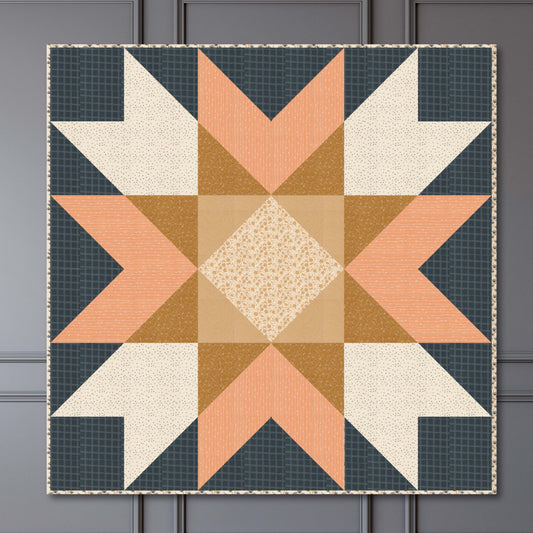
Quilts are not just beautiful pieces of fabric; they're labors of love, artful expressions, and cherished heirlooms.
Preserving handmade quilts for the long term requires careful attention and consideration.
In this blog post, we'll delve into the art of caring for and storing treasured quilts to ensure they remain in pristine condition for generations to come.

-
Cleanliness Comes First
Before storing a quilt for an extended period, ensure it is clean and free from dirt, dust, and stains.
Gently vacuum both sides of the quilt using a low suction upholstery attachment to remove any loose particles.
If washing is necessary, opt for a mild, pH-neutral detergent and a bathtub or large container to avoid agitating the fibers excessively.
 I usually wash on delicate cold. For quilts being actively used in the park, beach, car I sometimes wash regular or bulky with tap water.
I usually wash on delicate cold. For quilts being actively used in the park, beach, car I sometimes wash regular or bulky with tap water.
-
Proper Folding Techniques
Folding quilts correctly is crucial to prevent creases, stress on seams, and unnecessary wear.
To minimize strain, fold the quilt along the same lines as the original seams, which often mirror the block pattern.

Avoid sharp creases by gently padding the folds with acid-free tissue paper. This buffer helps distribute pressure and prevents fiber weakening.
If possible, alternate the folds over time to prevent permanent creasing.
Some quilters swear by rolling up quilts to keep them crease-free!

-
Say No to Direct Sunlight
Sunlight can cause irreversible damage to fabric fibers and dyes. When storing quilts, choose a location away from direct sunlight and fluorescent lighting.
UV rays can cause fading and discoloration, robbing your quilts of their vibrant hues. A cool, dark, and dry environment is the optimal choice to prevent deterioration.

-
Mindful Temperature and Humidity Control
Extreme temperatures and humidity fluctuations can be detrimental to quilt preservation.
Aim for a stable environment with temperatures between 65-70°F (18-21°C) and relative humidity around 50%.
Drastic changes in these conditions can lead to mold growth, weakening fibers, and even pest infestations.
If necessary, consider using a dehumidifier or humidifier to maintain the right levels.

-
Breathable Storage Containers
When storing quilts, opt for breathable storage containers made of acid-free materials.
Acid-free boxes or textile bags prevent the accumulation of moisture and allow the fabric to "breathe," reducing the risk of mold growth.
Make sure to label containers clearly to easily identify the contents without disturbing the contents.

-
Avoid Plastic and Cedar
While plastic bags might seem like a good idea for protection, they can trap moisture and promote the growth of mold and mildew.
Similarly, cedar chests or cedar-based products emit oils that can damage delicate quilt fibers.
Stick to acid-free tissue paper and textile storage options to ensure safe preservation.
-
Regular Inspection and Refolding
Even when stored properly, quilts should be inspected periodically to ensure their well-being.
Gently unfold and refold along different lines to avoid stress on any particular area.
Check for signs of discoloration, pests, or any other potential issues. This proactive approach can catch problems early, allowing for prompt intervention.

-
Pest Prevention
Quilts are susceptible to pest damage, particularly from moths and silverfish. To deter these unwelcome visitors, consider placing lavender sachets around the storage area.
However, ensure that these materials do not come into direct contact with the quilt, as discussed earlier.

Caring for Quilts
By following these tips, I hope your quilts remain vibrant, beautiful, and meaningful for years to come.
Remember, the preservation of these textile treasures isn't just about maintaining their physical integrity; it's also about preserving the stories and memories they carry within their stitches.
Happy Quilting!




3 comments
I really needed this information! Thank you for sharing ♥️
Great article! I’m always looks for a better way to store my quilts. I am constantly reshuffling use on the beds or the walls but storing…. can you give me a brand of a storage container that is breathable? Or where to find this? I even invested in “top down” “bottom up” lined roman shades so I can protect the quilts on the bed from sunlight at various angles of sun into the room. But I am concerned about tiny insects and dust. thank you!
———
Quiltd Studios replied:
It sounds like you’re already doing a great job at quilt preservation (honestly probably better than I am!!). If you google “fabric storage bags” or “fabric garment storage” you’ll find some links to breathable storage bags. I hope that helps! I use my husbands suit storage bags (folded or rolled).
I have also read in quilt magazines such as a Quilter’s Newsletter that folding quilts on the bias is a good way to avoid creases.since the bias is stinger than the perpendicular grains.
———
Quiltd Studios replied:
I love this, thanks for sharing!!